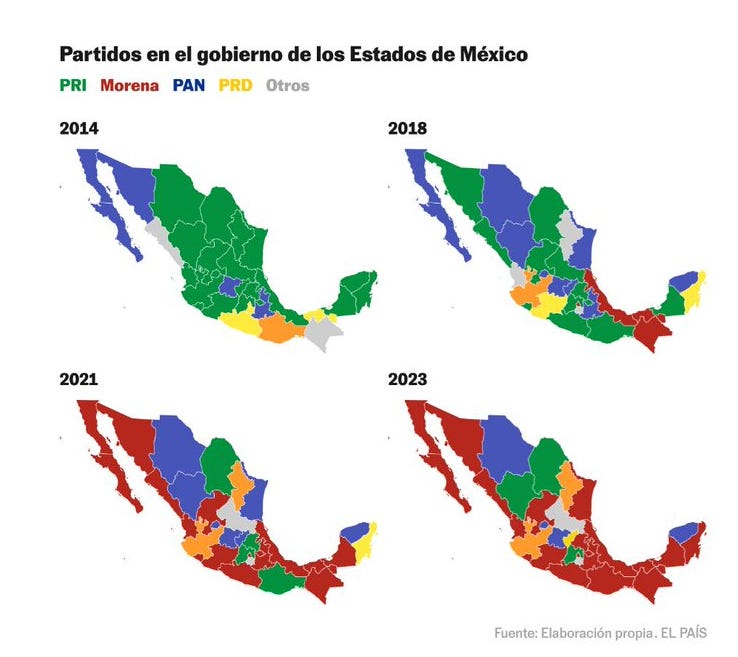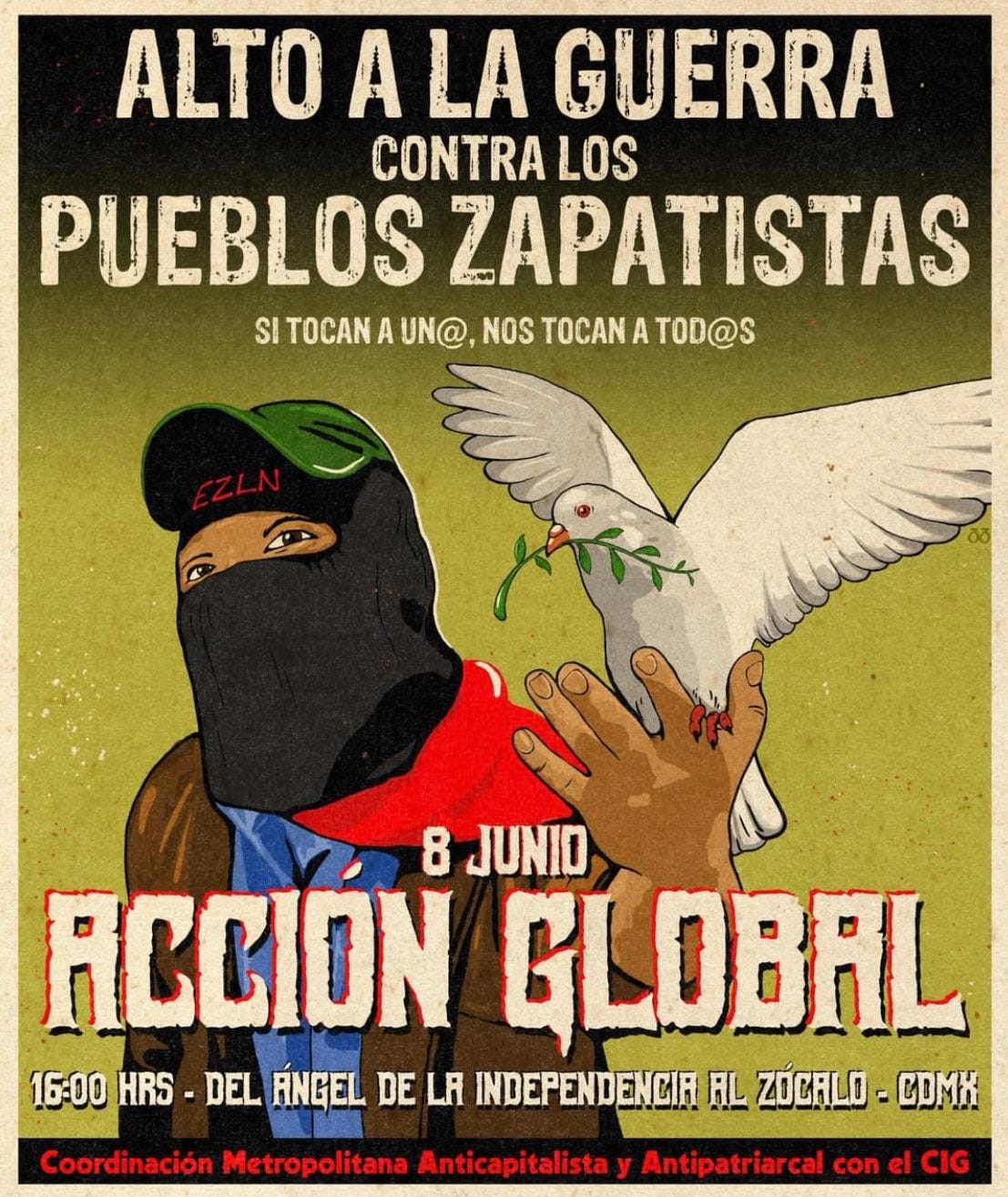Welcome to a brief news round-up edition of The Mexpatriate.
Morena makes history in Mexico state while PRI hangs on in Coahuila
As a heat wave brought temperatures as high as 45 degrees Celsius (113 Fahrenheit!) to parts of Mexico over the weekend, voters went to polling stations in two states, Coahuila and Mexico state (shorthand: Edomex). Last June, voters chose candidates from Morena (the president’s party) to lead as governors in four of six states, and in Sunday’s contests, Morena came out the winner in Edomex, while the PRI (Institutional Revolutionary Party) coalition clung on to Coahuila. Both states had been governed by the PRI for over 9 decades.
The first woman to govern Edomex will be Delfina Gómez, the former federal Secretary of Public Education, in coalition with the Ecological Green Party of Mexico (PVEM). In Coahuila, Morena struggled to herd a coalition, with a Labor Party (PT) and PVEM candidate also in the running until last week, and lost to the PAN-PRI-PRD candidate, Manolo Jiménez.
President López Obrador congratulated the winners on Monday, and invited Delfina Gómez and the “corcholatas” (aspiring candidates for Morena nomination) to dinner near the Palacio Nacional on Monday night. More chisme on that sure to come.
A few reactions to the elections from observers:
“Now what a paradox. The PRI, on its way to the tomb, takes the PAN with it. The buried one is doing the burying…”
-Carlos Pérez Ricart, professor at CIDE, on Twitter
“Clearly, this is not good news for the opposition. After this election, Morena becomes the undisputed territorial king. Not only does it govern 21 states, but at a state level, the party governs 70% of the population.”
-Viri Ríos, columnist in Milenio
“Winning Mexico state means breaking one of the last big barriers that remained, because of its historic association with the PRI. They [Morena] had already broken the barrier in the north with the PAN, and breaking down the one in Mexico state signifies a new level of territorial consolidation that changes all the political coordinates.”
Humberto Beck, Colegio de México professor (quoted in El País)
“The INE [National Electoral Institute] and the electoral system won. This was the first election since the commotion of ‘plan B’, the protests, the Supreme Court decision and the exit of Lorenzo Córdova [former president of the INE]. The day went smoothly, and peacefully. This is tremendous work by electoral authorities and thousands of polling station officials.”
Fernanda Caso, journalist
Is Chiapas “on the verge of civil war”?
“It’s not an exaggeration. The Chiapas powder keg could explode at any moment.” In a May 30 opinion column in La Jornada newspaper, Luis Hernández Navarro echoes a statement made by the Zapatista National Liberation Army (EZLN) on June 1, endorsed by over 1,000 individuals and 800 organizations (including Noam Chomsky, Juan Villoro, Diego Luna and some other high-profile figures), that claims the state is “on the verge of civil war”. They have called for a mass protest on June 8.
The Zapatistas’ statement blames violence perpetrated against their communities on “paramilitaries and gunmen from various cartels fighting over the plaza, and self-defense (autodefensa) groups” and claims both the state and federal governments are complicit. The EZLN issued a similar warning about Chiapas descending into civil war in September 2021.
While there have been attacks reported in autonomous Zapatista communities located near Ocosingo, starting on May 22, gunmen from rival cartels arrived in a town in another part of the state, near the border with Guatemala. Residents reported hearing incessant gun battles and grenade explosions as they hid, terrified, in their homes. A 15 year-old boy was killed by a stray bullet, and on May 26, people began to flee to escape the violence. According to media reports, there were repeated attempts to contact local law enforcement and the military base nearby, but to no avail.
On Friday, June 2, the National Guard began escorting the displaced residents—numbering as many as 3,000-4,000 by some accounts—back to their homes. There hasn’t been official confirmation, but some media have reported as many as 60 people dead from the confrontations. “We never thought, or even began to think, that we would live this reality,” said one of the women who left her home in an interview. “It is sad and terrible, it’s barbaric what they’re doing … When will it end? We don’t know.”
The Pegasus files
The story of Pegasus spyware and its zealous use in Mexico has a few new installments. Most recently, the Undersecretary for Human Rights and head of the Ayotzinapa truth commission, Alejandro Encinas, was found to be a victim of cyber-espionage, according to a report in The New York Times. And on Monday, The Washington Post reported that another official involved in a truth commission, historian Camilo Vicente Ovalle—this one investigating human rights violations during the “Dirty War” (1965-90)—was also found to have a Pegasus-infected cellphone. The national human rights commission (CNDH) said they have found no evidence the government is currently using the spyware, and said it is important to “clarify” who is carrying out espionage in Mexico.
The forensic lab responsible for the analysis in both cases is called Citizen Lab, and is part of the University of Toronto. The details about how easily the spyware can be inadvertently installed on a device makes for chilling reading. And once it’s been unknowingly installed, here is the information the “operator” has access to:
It’s hard to look away from—though AMLO is trying—the common link in these cases: investigation of the military, which turns out to be the only known entity to have had a contract with the makers of Pegasus in Mexico.
That’s it for today, but I’ll be back with more on Sunday. Thanks for reading, and please comment or send me an email with feedback or suggestions: hola@themexpatriate.com.








Thank you!